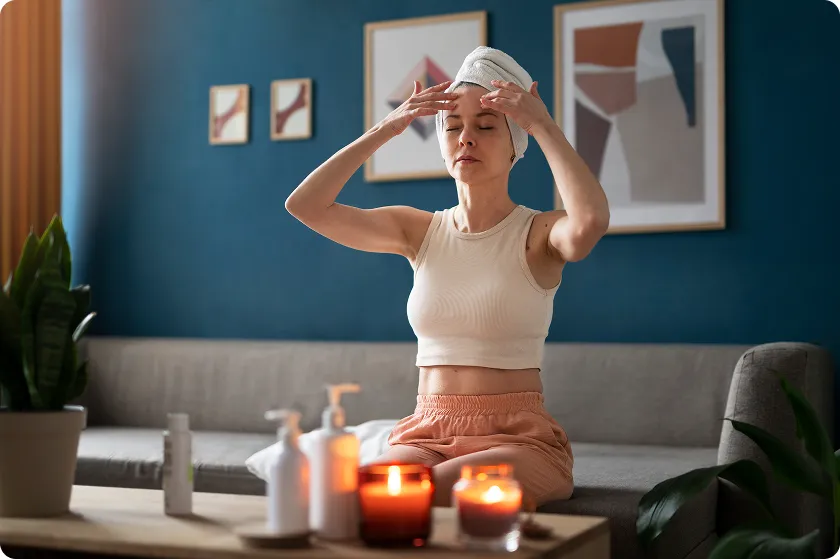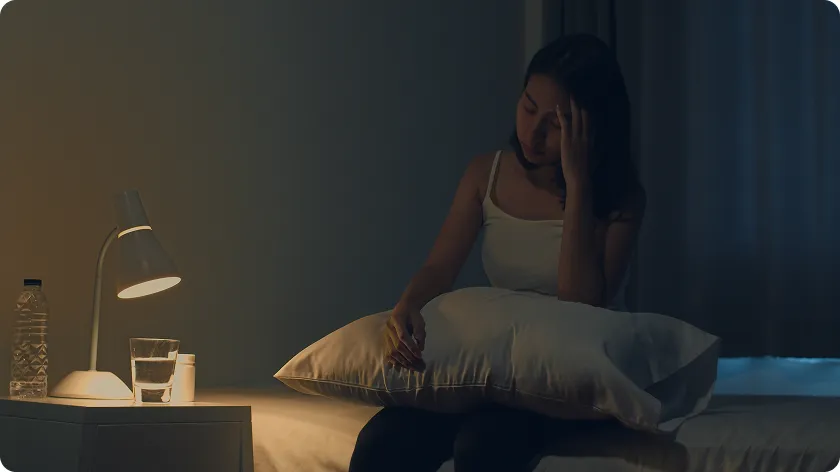Introduction
One of the most prevalent and manageable health issues that people encounter is inadequate sleep. You can take small, doable actions to enhance your energy, mood, memory, and general health with a clear sleep hygiene checklist. This post outlines eight comprehensive, scientifically supported strategies for improving the quality of your sleep that you can use tonight. By the end, you’ll have a workable plan that includes tools to help you fall and stay asleep, a reset protocol, and helpful advice.
1. Create a Consistent Sleep Schedule (Methods to Fall Asleep)
A steady schedule is the foundation of any effective sleep hygiene checklist. Going to bed and waking at similar times strengthens your circadian rhythm, making it easier to fall asleep quickly and feel alert during the day. Small timing changes—15–30 minutes—can add up and restore regular core sleep cycles.

The science behind sleep timing
Your body runs on a roughly 24-hour clock called the circadian rhythm. Light exposure, meals, and activity anchor this clock. When your sleep times drift, your melatonin rhythm and sleep architecture shift too, leading to sleepiness during the day and fragmented nights.
Practical nightly routine steps
- Choose a target wake time and keep it consistent, even on weekends.
- Work backwards to set a bedtime that allows 7–9 hours of sleep.
- Build a 30–60 minute wind-down routine: dim lights, low-stimulation activity, and calming habits.
Track and tweak your schedule
Tracking helps find what truly works. Use a sleep journal or tracker app to note bedtime, wake time, caffeine, naps, and perceived sleep quality. Adjust gradually—change by 15 minutes every few days—to avoid disrupting your rhythm.
Simple Sleep Schedule Checklist
| Habit | Inconsistent Schedule | Consistent Schedule (Goal) |
| Bedtime | Varies 1–3+ hours | Same ±15 minutes |
| Wake time | Varies widely | Same daily |
| Energy next day | Groggy, naps needed | Alert, steady energy |
| Deep sleep | Reduced | Improved deep sleep percentages |
| Tip | Try late-bed weekends | Use light exposure morning |
2. Design a Sleep-Friendly Bedroom Environment (Techniques to Fall Asleep)
Instead of being a multipurpose workstation, your bedroom should be a haven for peaceful sleep. The primary environmental factors that you can regulate to improve the quality of your sleep are temperature, light, and noise levels. Quick wins are frequently obtained with minor environmental improvements.

Light, temperature, and darkness
Bright light suppresses melatonin. Aim for dim, warm lighting before bed and blackout curtains at night. Keep the bedroom cool — most sleep experts recommend about 60–67°F (15–19°C) as a comfortable range for many adults.
Sound control and scents
Use white noise, fans, or soft ambient sound to mask sudden disturbances. Many people find lavender and similar calming scents helpful; use them sparingly and test for allergies. Soundproofing small gaps or using earplugs can reduce sleep disturbances.
Comfort, bedding, and clutter
A comfortable mattress and pillows make it easier to fall asleep. Remove work items and screens from the bedroom to create a restful space. A tidy room can reduce evening mental clutter and promote inner peace at sleepy time.
3. Master Tricks and Techniques to Fall Asleep Fast (Tricks to Fall Asleep)
When you lie in bed awake, a few reliable tricks to fall asleep can rescue the night. These are behavioral and cognitive tools that calm the nervous system and quiet the mind. You don’t need medication to learn them—practice matters.

Breathing and relaxation techniques
For instance, the 4-7-8 breathing technique involves inhaling for 4 seconds, holding for 7, and exhaling for 8. This activates your parasympathetic nervous system and lowers your heart rate. To ease tension and promote rapid sleep, apply this technique while lying in bed.
Mindfulness and progressive muscle relaxation
Tensing and relaxing muscle groups from the toes to the head is known as progressive muscle relaxation. This eases tension in the body and raises awareness of calm. Another effective method for getting a good night’s sleep is to do brief guided meditations that concentrate on the breath or body scan.
Cognitive approaches to stop racing thoughts
When worry keeps you awake, a simple cognitive trick helps: jot down three next-day to-dos and three things that went well today. Offload the list and give your brain permission to rest. Visualization—a safe, slow scene—can also distract from anxious loops and help you drift off.
Use Proven Methods to Fall Asleep Naturally (What Are Methods to Fall Asleep)
Natural, evidence-based methods to fall asleep focus on behavior, stimulus control, and habit formation. For many people, structured approaches like CBT-I or stimulus control beat pills for long-term success.

Behavioral methods: CBT-I basics
Cognitive behavioral therapy for insomnia (CBT-I) assists in changing sleep-related attitudes and behaviors. Sleep restriction (limiting time in bed to consolidate), cognitive restructuring, and stimulus control (reserving the bed for sleep or sex) are important components. Think about utilizing verified online programs or collaborating with a qualified provider.
Physical relaxation methods
Gentle yoga, stretching, or a warm bath about 60–90 minutes before bed can lower core temperature and relax muscles. These physical cues make it easier to transition to restful sleep.
What to avoid near bedtime
Avoid caffeine after mid-afternoon, heavy meals within two hours of bed, and stimulating screen use right before sleep. Blue light from devices reduces melatonin and can delay sleep onset.
Try a Complete Sleep Reset (Sleep Reset Plan)
A sleep reset is a short, intentional program to re-align your sleep clock — useful after travel, shift work, or weeks of poor sleep. A reset combines strict timing, light exposure, and consistent routines to re-entrain circadian rhythms.

When to do a sleep reset
Use a sleep reset after repeated late nights, jet lag, or when irregular schedules have accumulated. It’s also helpful if naps or late caffeine have shifted your entire sleep window.
A practical 7-day reset plan
- Day 1–2: Set a firm wake time and avoid naps. Seek bright morning light.
- Day 3–5: Gradually move bedtime earlier by 15–30 minutes if needed. Keep evening light low.
- Day 6–7: Reinforce wind-down routine and avoid screens 60 minutes before bed. Evaluate progress and adjust.
Keeping the reset long-term
Once your rhythm returns, keep the key anchors: consistent wake time, morning light exposure, and a nightly wind-down. Mark this plan with an annual review if your schedule changes (e.g., shift work season).
Increase Deep Sleep with Science-Backed Habits (Increase Deep Sleep)
Deep sleep is when the body repairs and memory consolidation happens. To increase deep sleep, combine daytime behavior, evening routines, and dietary choices. Small changes can raise the proportion of restorative sleep you get each night.

Nutrition, supplements, and timing
Avoid late heavy meals and alcohol before bed—both fragment deep sleep. Nutrients linked to sleep quality include magnesium and some B vitamins. Low-dose melatonin may help adjust timing for short periods, but speak with a clinician before starting supplements.
Exercise timing and type
Regular aerobic exercise and resistance training support more deep sleep, especially when done earlier in the day. Late high-intensity workouts can be stimulating for some people, so schedule them at least 3–4 hours before bed.
Sleep stages and habits that support core sleep
Consistency, cool bedroom temperature, and limiting night disruptions protect deep sleep. Use the sleep hygiene checklist to emphasize consistent routines that favor uninterrupted cycles of core sleep and deep stages.
Manage Sleep Disturbances and Nighttime Wakeups (Sleep Disturbances)
Waking at night is common. The goal is not zero awakenings—humans wake briefly—but to limit prolonged wakefulness that damages sleep quality. Identifying and addressing the underlying cause restores sound sleep.

Common causes of wakeups
Nighttime awakenings can be triggered by stress, bathroom trips, pain, sleep apnea, or environmental noise. Hormonal changes, medications, and alcohol are also frequent culprits. A log of timing and triggers helps pinpoint common patterns.
Practical coping strategies during wakeups
If you wake and cannot return to sleep after 20 minutes, get up and do a calming, dimly lit activity until you feel sleepy again. Avoid screens and bright lights. Use slow breathing, warm herbal tea (non-caffeinated), or light stretching to relax.
When to seek professional help
Seek evaluation if you snore loudly with gasping (possible sleep apnea), have repeated long wake periods, or daytime function suffers despite sleep efforts. A sleep specialist or your primary care clinician can recommend testing or therapy such as CBT-I.
Natural Remedies and Relaxation Techniques for Sound Sleep (Natural Remedies for Insomnia)
Natural remedies often complement behavioral approaches in a sleep hygiene checklist. Herbs, low-dose supplements, and sensory therapies can ease falling asleep for many people, but they work best alongside consistent habits.

Herbal and nutritional options
Common remedies for mild sleep issues include magnesium, valerian root, and chamomile tea. More than it does for general insomnia, melatonin helps with timing problems. To prevent interactions and to confirm dosage, always consult a healthcare professional.
Sensory and mind-body techniques
Aromatherapy, gentle massage, sound therapy, and guided imagery can cue relaxation responses. Experiment to see which sensory options best signal sleepy time for you.
Blending remedies with routine for lasting results
Combine natural remedies with the behavioral pillars: schedule, environment, and wind-down. Remedies are most effective when they complement, not replace, consistent sleep-promoting habits.
FAQ: Quick Answers to Common Sleep Questions
This FAQ answers common searches and clarifies quick steps you can try tonight. Each response aims to be practical and compassionate for readers seeking immediate help.

1. What is the fastest way to fall asleep?
The fastest way often combines breathing and stimulus reduction: dim lights, do a paced breathing exercise (like 4-7-8), and focus on a calm visualization. Avoid screens and bright light for at least 30–60 minutes beforehand to let melatonin rise naturally.
2. How can I increase my deep sleep naturally?
Increase deep sleep by keeping a consistent schedule, exercising regularly (not too close to bedtime), cooling your bedroom, and avoiding alcohol late in the evening. These habits reinforce uninterrupted cycles that boost deep, restorative sleep.
3. What are tricks to fall asleep quickly?
Short tricks include progressive muscle relaxation, 4-7-8 breathing, and the “mental alphabet” visualization (think of objects that begin with each letter slowly). These techniques calm the nervous system and distract from worry.
4. How can I help myself go to sleep at night?
Start with a predictable wind-down routine, reduce evening stimulation, and create a cool, dark bedroom. If anxiety is the cause, write a short “worry list” earlier in the evening to offload thoughts before bed.
5. What are natural remedies for insomnia?
Herbal options like chamomile, valerian, and magnesium supplements can help some people. Use them alongside behavioral methods; they rarely fix chronic insomnia on their own.
6. What is the best way to reset my sleep schedule?
A focused sleep reset begins with a consistent wake time and morning light exposure, avoids naps during the reset, and gradually shifts bedtime earlier if necessary. Follow a structured plan for 5–7 days and keep anchors after the reset.
Conclusion: Start Your Sleep Hygiene Checklist Tonight
You can take charge of your nights and have more energy during the day with a targeted sleep hygiene checklist. Restorative, restful sleep can be restored by combining the eight strategies listed above: a regular schedule, a calm environment, breathing exercises, natural methods, a sleep reset, deep sleep habits, disturbance management, and gentle remedies.

Set a consistent wake-up time, turn down the lights, and try a breathing technique as your first change for tonight. For individualized support, speak with a healthcare provider if issues continue. To keep getting better sleep, read the guides that are linked or share what worked for you.
Internal Links:
- Success Starts Here: 2025 Healthy Morning Routine
- Smart Metabolism Tracking Devices in 2025
- Digital Detox 101: Take Back Your Time & Mind



